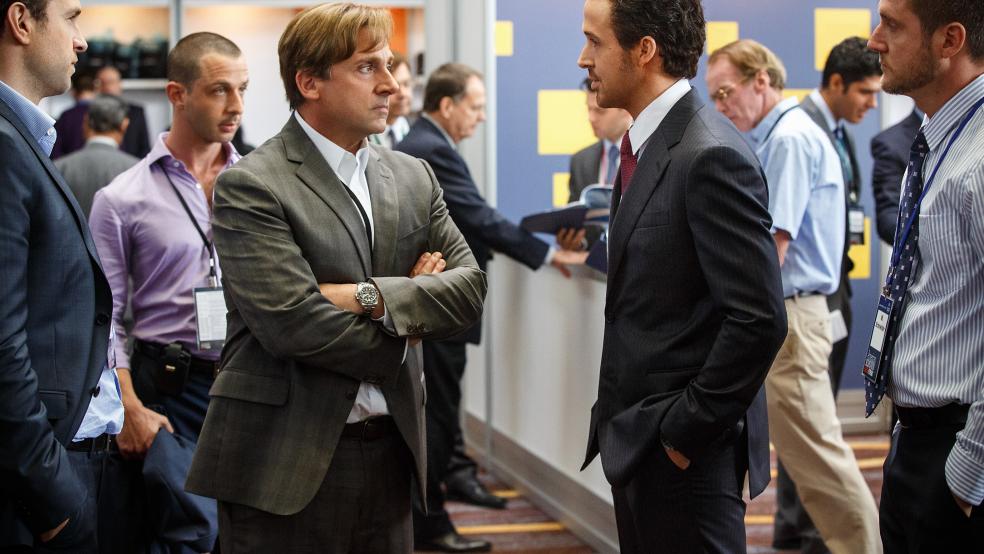The financial crisis is back. No, this doesn’t mean you should stock up on canned food and bottled water and clean out your underground survival bunker. It means “The Big Short,” Adam McKay’s adaptation of the Michael Lewis narrative about a few outsider investors who saw the implosion of the housing market coming before the crash of 2008, hits theaters in limited release today. (It goes nationwide on Dec. 23.)
If you want to know what really triggered the crisis, read the book: The limitations of a standard-length film that also seeks to entertain require McKay to compress and whip through things a bit. Most of the main characters — like Ryan Gosling’s Deutsche Bank trader Jared Vennett, or Steve Carell’s hedge fund manager Mark Baum, are composites.
That said, McKay does yeoman work in breaking down the layered scheme of mortgage-backed securities, collateralized debt obligations (CDOs) and synthetic derivatives, including using celebrity explainers from Margot Robbie and Selena Gomez to demystify Wall Street complexities. The film actually draws from Lewis’ first book, Liar’s Poker, opening with Lew Ranieri, the godfather of mortgage trading, who invented the instrument that greedy financiers later weaponized.
Related: The 12 States with the Hottest Housing Markets
And McKay does capture much of the insanity of the bubble — how the entire mortgage industry, driven by underlying incentives, encouraged millions to take out loans they couldn’t possibly afford, in the belief that the risk could be offloaded elsewhere, insulating them from the damage. The mortgage brokers sold their loans to the banks, who packaged them into securities, tossing the hot potato to unwitting investors. The ratings agencies blessed the scheme so they could keep getting business from the issuers. Middlemen traders made bets on top of bets to collect fees. Everybody profited until everybody didn’t.
To the extent that there’s a villain, it’s a laughing chorus of bankers, brokers and investors, either delusional in their belief that the bubble would never pop or faking this fortitude to bluff their way out of trouble (the scene with the CEO of now-defunct subprime lender Option One, assuring a crowd that his losses will be “contained at 5 percent,” is a gem).
The Big Short walks a fine line between blaming the crisis on stupidity or corruption, mindful that corruption — and especially the money that comes with it — makes you stupid.
But the film’s limitations are inherent in the source material. Like most Michael Lewis stories, it follows a handful of “outsiders and weirdos” who challenge the system through common sense. Mike Burry (Christian Bale), the California investment advisor who first shorted mortgages, did so because he “cracked the loan tapes” and actually read the mortgages inside the bonds. (It’s worth noting that Burry was partially wrong — resets to adjustable-rate loans weren’t the problem as much as multiple refinances that increased loan values. The tip-off that the party was over came from early payment defaults — people who couldn’t make their first mortgage payments, even on a teaser rate loan.)
But the fact that these outsiders were short sellers, people who bet on the housing market to fail and eventually won, adds a certain bloodless quality to the proceedings. The filmmakers are certainly aware of the moral ambiguities of having the audience root for people seeking a payday from economic failure. Brad Pitt’s mountain-man ex-trader lays this out to his protégés in one noteworthy scene, telling them that their victory equals pain for millions of people who did nothing wrong.
Related: The Mortgage Market Is on Track to Finally Recover in 2016
It’s true that, if we had more skeptics and short-sellers, the bubble would not have grown so big, and the crisis would not have been so acute. But the everyday people Pitt’s character stands up for only flitter in the background. Only two homeowners — a renter whose landlord is late on the mortgage, and a stripper with five homes — have speaking parts. The rest of the unwashed masses exist in the film as wallpaper, seen only in quick shots of tent cities huddled around an underpass, or grim faces at a job fair. The heroes of The Big Short are soulless, to some degree. But the ordinary Americans with a soul are invisible.
An earlier film this year, 99 Homes, did bring a human angle to the foreclosure crisis. In The Big Short it’s only discussed in the abstract. Until you see how, as Carell’s Mark Baum says at the end, “average people will pay” for the banking industry’s sins, you aren’t fully experiencing the injustice of that event.
This way in which too many crisis narratives write ordinary people out of the picture actually makes us more vulnerable to a replay. That’s especially true because the new dangers won’t come from the same place.
The Big Short tells us to keep the focus on Wall Street: A caption at the end highlights a new product being sold called a “bespoke tranche opportunity,” just another word for a CDO. But the underlying assets in these derivatives are largely corporate debt, and the numbers are so far pitifully small — $20 billion a year, compared to the trillion dollars annually in securitized subprime loans during the bubble. Private securitization for mortgages has been basically flat for seven years.
Related: House Flippers Are Back – Here’s How Much They’re Making
Today, over 90 percent of risky mortgages with low down payments are Federal Housing Administration or Veterans Administration loans, with the risk offloaded to the government. Non-bank lenders, many of them based in the same southern California hotspots that were ground zero for the bubble (and with executives from the last crop of subprime lenders), are dominating these high-risk loans, and increasing their share of the overall mortgage market as the banks recede. And non-bank loans fail at higher rates than their counterparts’.
The biggest threat actually comes from Silicon Valley, which has made a play for the lending market. Early stories vividly recall the go-go bubble years. “Most borrowers don’t need to submit tax returns” for a mortgage from emerging online lender SoFi, according to Bloomberg. One man got a million-dollar mortgage on his phone. Lenda, a startup with only 12 employees, qualifies borrowers through an online survey. At others, the entire approval process can take eight minutes.
The online loan from Prosper to Syed Farook, the San Bernardino shooter, is the most extreme example of how a no-questions-asked process can go sour. More troubling is how “disruptive” companies besotted with venture capital make money so freely available to people who may not understand the risks.
You see the same pitfalls here as the last crisis — over-reliance on technology, a focus on speed and customer convenience over prudence, the advantage of being lightly regulated, if at all. SoFi and other online lenders fund mortgages through lines of credit with big banks, an echo of the crisis era. They also plan to bundle mortgages into bonds.
Related: These Simple Steps Could Prevent Another Financial Crisis
Right now this is a market in its infancy. But so were subprime originators in the late 1990s. Ten years later they nearly upended the global economy. Regulators can police lending markets — their work to tamp down the growing trade in leveraged loans is one of the great regulatory victories of recent years — but that means looking at all the ways borrowers secure funds.
The Big Short offers a morality play about how Wall Street screwed America before and will do so again. That’s an important tale to tell. But there’s more risk out there beyond Wall Street. And unless we put the focus directly on people — where they are sold risks and by whom — we will not find those trouble spots until it’s too late.






